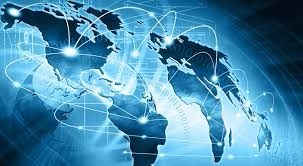
A computer network or data network is a telecommunications network which allows computers to exchange data. In computer networks, networked computing devices exchange data with each other along network links (data connections). The connections between nodes are established using either cable media or wireless media. The best-known computer network is the Internet.
Network computer devices that originate, route and terminate the data are called network nodes.Nodes can include hosts such aspersonal computers, phones, servers as well as networking hardware. Two such devices can be said to be networked together when one device is able to exchange information with the other device, whether or not they have a direct connection to each other.
Computer networks differ in the transmission media used to carry their signals, the communications protocols to organize network traffic, the network's size, topology and organizational intent. In most cases, communications protocols are layered on (i.e. work using) other more specific or more general communications protocols, except for the physical layer that directly deals with the transmission media.
Computer networks support an enormous number of applications such as access to the World Wide Web, video, digital audio, shared use of application and storage servers, printers, and fax machines, and use of email and instant messaging applications as well as many others.
History
The chronology of significant computer-network developments includes.
- In the late 1950s early networks of computers included the military radar system Semi-Automatic Ground Environment (SAGE).
- In 1959 Anatolii Ivanovich Kitov proposed to the Central Committee of the Communist Party of the Soviet Union a detailed plan for the re-organisation of the control of the Soviet armed forces and of the Soviet economy on the basis of a network of computing centres.
- In 1960 the commercial airline reservation system semi-automatic business research environment (SABRE) went online with two connected mainframes.
- In 1962 J.C.R. Licklider developed a working group he called the "Intergalactic Computer Network", a precursor to the ARPANET, at the Advanced Research Projects Agency (ARPA).
- In 1964 researchers at Dartmouth College developed the Dartmouth Time Sharing System for distributed users of large computer systems. The same year, at Massachusetts Institute of Technology, a research group supported by General Electric and Bell Labs used a computer to route and manage telephone connections.
- Throughout the 1960s, Leonard Kleinrock, Paul Baran, and Donald Davies independently developed network systems that used packets to transfer information between computers over a network.
- In 1965, Thomas Marill and Lawrence G. Roberts created the first wide area network (WAN). This was an immediate precursor to the ARPANET, of which Roberts became program manager.
- Also in 1965, Western Electric introduced the first widely used telephone switch that implemented true computer control.
- In 1969 the University of California at Los Angeles, the Stanford Research Institute, the University of California at Santa Barbara, and the University of Utah became connected as the beginning of the ARPANET network using 50 kbit/s circuits.
- In 1972 commercial services using X.25 were deployed, and later used as an underlying infrastructure for expanding TCP/IP networks.
- In 1973, Robert Metcalfe wrote a formal memo at Xerox PARC describing Ethernet, a networking system that was based on the Aloha network, developed in the 1960s by Norman Abramson and colleagues at the University of Hawaii. In July 1976, Robert Metcalfe and David Boggs published their paper "Ethernet: Distributed Packet Switching for Local Computer Networks" and collaborated on several patents received in 1977 and 1978. In 1979 Robert Metcalfe pursued making Ethernet an open standard.[5
- In 1976 John Murphy of Datapoint Corporation created ARCNET, a token-passing network first used to share storage devices.
- In 1995 the transmission speed capacity for Ethernet increased from 10 Mbit/s to 100 Mbit/s. By 1998, Ethernet supported transmission speeds of a Gigabit. The ability of Ethernet to scale easily (such as quickly adapting to support new fiber optic cable speeds) is a contributing factor to its continued use as of 2015.
Properties
Computer networking may be considered a branch of electrical engineering, telecommunications, computer science, information technology or computer engineering, since it relies upon the theoretical and practical application of the related disciplines.
A computer network facilitates interpersonal communications allowing users to communicate efficiently and easily via various means: email, instant messaging, chat rooms, telephone, video telephone calls, and video conferencing. Providing access to information on shared storage devices is an important feature of many networks. A network allows sharing of files, data, and other types of information giving authorized users the ability to access information stored on other computers on the network. A network allows sharing of network and computing resources. Users may access and use resources provided by devices on the network, such as printing a document on a shared network printer.Distributed computing uses computing resources across a network to accomplish tasks. A computer network may be used by computer crackers to deploy computer viruses orcomputer worms on devices connected to the network, or to prevent these devices from accessing the network via a denial of service attack.



